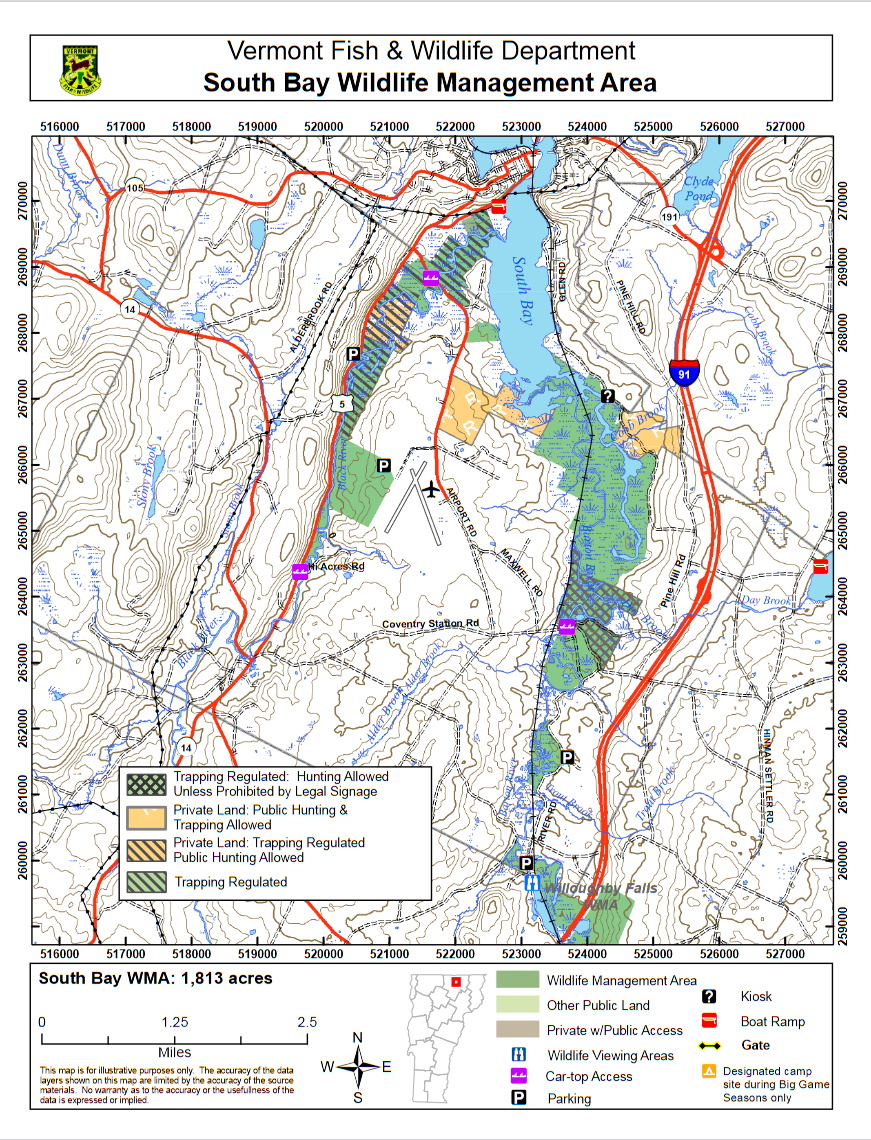South Bay WMA (IBA)
South Bay WMA (IBA)
Newport, Vermont 05855
South Bay Wildlife Management Area guide and mapSouth Bay Wildlife Management Area (Audubon IBA) webpage
Tips for Birding
Birdwatching in Vermont, pp. 109-110.
Birds of Interest
South Bay Wildlife Management Area is an important waterfowl production and migration area, particularly for black ducks, mallards, and wood ducks. The red maple floodplain forests provide important food and nesting habitat for wood ducks, goldeneyes, and hooded mergansers, and the marshes and associated open water areas are excellent mallard and black duck brooding habitat. Favorable ruffed grouse habitat on the WMA is limited to the old fields and pine-aspen forest west of the Newport Airport. The great diversity of forested and wetland habitats provides excellent bird-watching opportunities, particularly for wetland and marsh species. Herons, bitterns, ospreys, northern harriers, snipe, pied-billed grebes, rails, common moorhens, marsh wrens, black terns, and occasionally bald eagles inhabit the marshes. Many other species including flycatchers, swallows, barred owls, great horned owls, red-tailed hawks, and many neotropical migrants are found on the WMA. The rare upland sandpiper has nested in the fields near the Newport Airport.
About South Bay Wildlife Management Area
See all hotspots at South Bay Wildlife Management Area
South Bay Wildlife Management Area (WMA) is comprised of a composite of publicly and privately owned lands. It is located primarily in two separate blocks totaling 1,813 acres. It is managed by the Vermont Fish and Wildlife Department. Both blocks are dominated by wetland complexes where large meandering rivers (the Barton and the Black) enter the South Bay of Lake Memphremagog. The WMA ownership pattern is complex, as there are State parcels held in fee ownership, private lands to which the State has been permanently deeded hunting, fishing, and/or trapping rights, and parcels owned by the State upon which private individuals have retained trapping and/or hunting rights.
Access can be had from three boat accesses and roads on three sides of the WMA.
A diverse mosaic of wetlands dominates the WMA. These include extensive red maple–northern white cedar swamps, sweet gale–buttonbush shrub swamps, riverine floodplain forests, sedge meadows, cattail marshes, and bulrush–bur-reed marshes in deeper water. An upland parcel west of the Newport Airport contains two old fields with scattered apple trees and a stand of white pine. Hunting rights exist for an upland field and white pine stand northeast of the airport and for several fields east of Miller’s Pond.
Most of the wetlands are considered ecologically significant, and the red maple–cedar swamps and shrub swamps are excellent examples of these natural communities. A fen in the Barton Block is a habitat for three rare plants. The thin-flowered sedge and State-endangered creeping sedge are also present. The Barton River portion of the WMA was designated a National Natural Landmark by the National Park Service in 1973.
South Bay Wildlife Management Area is designated as an Important Bird Area by the National Audubon Society.
Features
Restrooms on site
Wheelchair accessible trail
Entrance fee
Content from South Bay Wildlife Management Area guide and map
Last updated October 18, 2023
